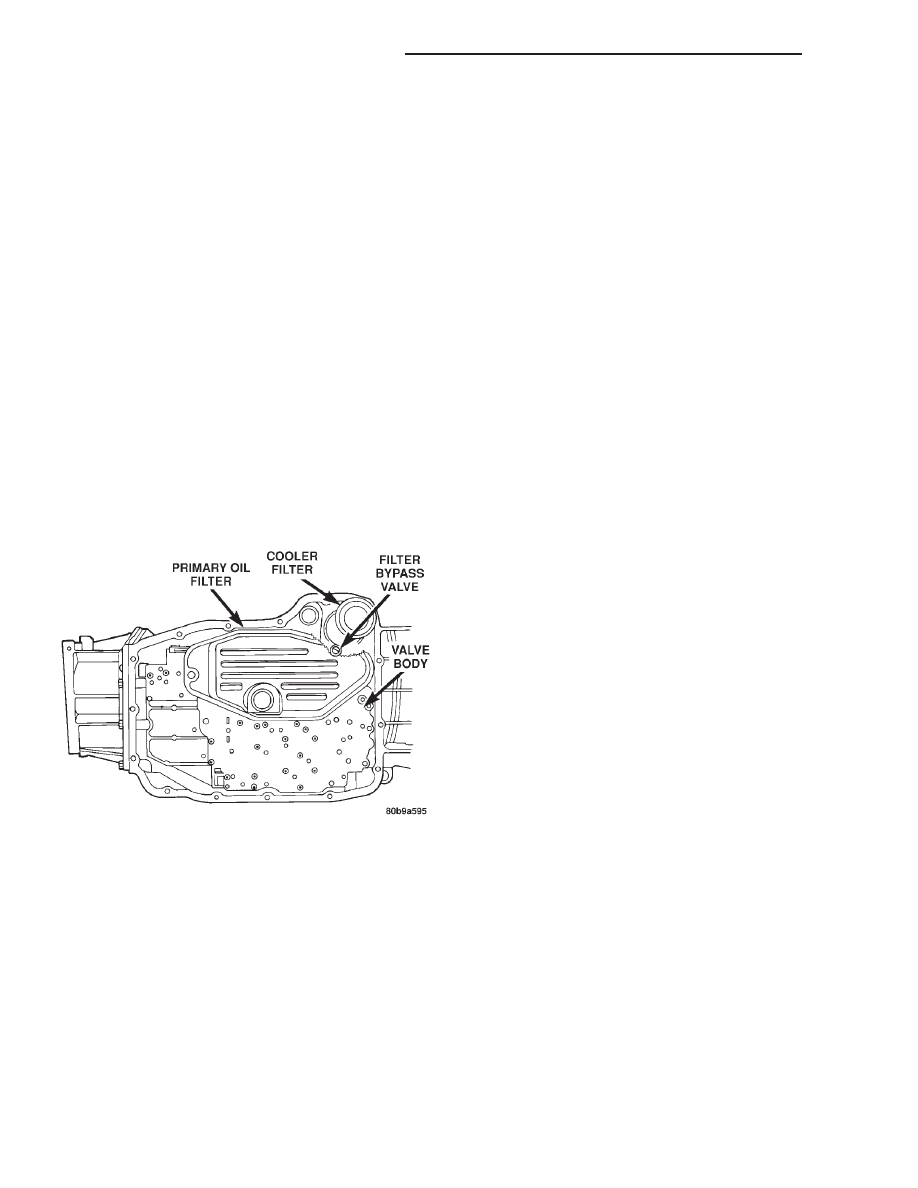Dodge Durango (DN). Manual - part 123

REMOVAL
(1) Hoist and support vehicle on safety stands.
(2) Place a large diameter shallow drain pan
beneath the transmission pan.
(3) Remove bolts holding front and sides of pan to
transmission.
(4) Loosen bolts holding rear of pan to transmis-
sion.
(5) Slowly separate front of pan away from trans-
mission allowing the fluid to drain into drain pan.
(6) Hold up pan and remove remaining bolt hold-
ing pan to transmission.
(7) While holding pan level, lower pan away from
transmission.
(8) Pour remaining fluid in pan into drain pan.
(9) Remove screws holding filter to valve body
(Fig. 36).
(10) Separate filter from valve body and oil pump
and pour fluid in filter into drain pan.
(11) Remove and discard the oil filter seal from the
bottom of the oil pump.
(12) Using Oil Filter Wrench 8321, remove the
cooler return filter from the transmission.
(13) Dispose of used trans fluid and filter properly.
INSPECTION
Inspect bottom of pan and magnet for excessive
amounts of metal. A light coating of clutch material
on the bottom of the pan does not indicate a problem
unless accompanied by a slipping condition or shift
lag. If fluid and pan are contaminated with excessive
amounts or debris, refer to the diagnosis section of
this group.
CLEANING
(1) Using a suitable solvent, clean pan and mag-
net.
(2) Using a suitable gasket scraper, clean original
sealing material from surface of transmission case
and the transmission pan.
INSTALLATION
(1) Install a new oil filter seal into the bottom of
the oi pump.
NOTE: Do not attempt to install the seal onto the
oil filter first and then into the oil pump. An unsat-
isfactory seal between the oil pump and filter will
result, allowing air to be drawn into the pump.
(2) Place replacement filter in position on valve
body and into the oil pump.
(3) Install screws to hold filter to valve body (Fig.
36). Tighten screws to 4.5 N·m (40 in. lbs.) torque.
(4) Install new cooler return filter onto the trans-
mission. Torque the filter to 14.12 N·m (125 in.lbs.).
(5) Place bead of Mopar
t RTV sealant onto the
transmission case sealing surface.
(6) Place pan in position on transmission.
(7) Install screws to hold pan to transmission.
Tighten bolts to 11.8 N·m (105 in. lbs.) torque.
(8) Lower
vehicle
and
fill
transmission
with
Mopar
t ATF Plus 3, type 7176 fluid.
TRANSMISSION FILL PROCEDURE
To avoid overfilling transmission after a fluid
change or overhaul, perform the following procedure:
(1) Remove dipstick and insert clean funnel in
transmission fill tube.
(2) Add following initial quantity of Mopar
t ATF
Plus 3 to transmission:
(a) If only fluid and filter were changed, add 10
pints (5 quarts) of ATF Plus 3 to transmission.
(b) If transmission was completely overhauled,
torque converter was replaced or drained, and
cooler was flushed, add 24 pints (12 quarts) of
ATF Plus 3 to transmission.
(3) Refer to the Fluid Level Check information in
this group for the proper fill procedures.
OIL PUMP VOLUME CHECK
Measuring the oil pump output volume will deter-
mine if sufficient oil flow to the transmission oil
cooler exists, and whether or not an internal trans-
mission failure is present.
Verify that the transmission fluid is at the proper
level. Refer to the Fluid Level Check procedure in
this section. If necessary, fill the transmission to the
proper level with Mopar
t ATF+3, type 7176, Auto-
matic Transmission Fluid.
(1) Disconnect the To cooler line at the cooler
inlet and place a collecting container under the dis-
connected line.
Fig. 36 Transmission Filters
21 - 358
45RFE AUTOMATIC TRANSMISSION
DN
SERVICE PROCEDURES (Continued)